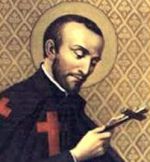Feastday Highlights: St. Luke, Evangelist and Artist
By Jennifer Gregory Miller ( bio - articles - email ) | Oct 17, 2014
The month of October is filled with many memorials and optional memorials of saints, but the only two feasts during the month are for St. Luke, Evangelist on October 18, and ten days later Saints Simon and Jude, apostles.
Not much is known about St. Luke's life, nor his death. Tradition says he never met Jesus while He was on earth but was a companion to St. Paul, and thought to have been close to the Blessed Virgin Mary. His gospel has particular focus on Our Lady and contains the Canticles that are repeated every day in the Liturgy of the Hours: Morning Prayer: Canticle of Zechariah (Benedictus), Evening Prayer: Magnificat and Night Prayer: Canticle of Simeon (Nunc Dimittis). St. Luke also wrote the Acts of the Apostles, the action-packed account of the early Church, read at Mass particularly throughout the Easter season.
In our family, I like to emphasize the various "levels" of feast days, and since feasts are higher than memorials and optional memorials, St. Luke will be honored in a special way. At home besides stressing the writings of St. Luke in the New Testament, we will be highlighting three aspects of St. Luke on his feast (and perhaps into next week, since his feast is on Saturday. We have been known to prolong some feasts!):
1) A Little Art Study
Besides being a writer and physician, legend has that St. Luke was an artist. There are multiple images of Our Lady which bear the claim to St. Luke's hand. The three most famous ones:
- Black Madonna of Czestochowa found in the Jasna Gora Monastery in Czestochowa, Poland.

- Our Lady of Perpetual Help curated by the Redemptorist order and located in the Church of St. Alphonsus Liguouri in Rome.

- Protectress of the Roman People or Salus Populi Romani located in the Basilica of St. Mary Major in Rome.

Our little "art study" is nothing lengthy or studious, but merely a presentation of some of the images, and discussion of their history and style. There are so many images claimed to be painted by St. Luke all over the world. Could they all come from his brush? Which ones have the same style and which ones are completely different? Which styles are similar to the early church paintings?
We will also discuss the works of art that depict St. Luke painting the Virgin. This was a favorite subject to paint, and there are many examples over the centuries. A quick Internet search can pull up dozens of examples. Since St. Luke's Gospel includes the infancy narrative of Jesus, many of these depictions are Madonna and Child, especially depicting Mary nursing her Son. Two of my favorites:
- St. Luke Painting the Virgin by Derick Baegert, c. 1470

- St. Luke Painting the Virgin and Child by El Greco before 1567. This painting is located in Athens and is quite damaged, but there is great similarity to the icon of Perpetual Help

2) What Are Our Talents?
St. Luke painted both word pictures through his writing and pictures with brush and paint. He communicated the Good News through beauty and the written word (and spoken, since he traveled with St. Paul). If we look at his patronage, we see how many people who work with their hands invoke St. Luke: artists; bookbinders; brewers; butchers; glassworkers; goldsmiths; lacemakers; notaries; painters; physicians; sculptors; stained glass workers; surgeons.
We can ask St. Luke to help us discover and develop our talents, so we can use them for the glory of God. We also ask his intercession to help us in our communication, asking aid to improve our writing and speaking. If we can't communicate well, how can we evangelize well?
3) Focus on Food
All four evangelist have different depictions: St. Matthew is the winged man or angel, St. Mark is the winged lion, St. John is the eagle, and St. Luke is the winged ox or bull.
As the commercial said, "Beef, it's what's for dinner" -- at least for St. Luke's day, although probably something simple as hamburgers. The showcase will be dessert. St. Luke's feast falls during apple harvest time and many of us are experiencing St. Luke's Summer. Our family goes to the local farmer's market in the morning, and this visit we will get apples for the week and for dessert.
The tradition I want to draw in the "sour cakes" tradition of Scotland, using sour cream in the cake, so a Sour Cream Apple Cake would fit the bill! No apples? I highly recommend the Sour Cream Pecan Coffee Cake instead! Not only will either of these be a nice dessert to frame a feast day, it also can do double (or triple) duty for Sunday morning breakfast or dessert (if you have leftovers). After all, every Sunday is a little Easter!
If we are praying with the Church through the Mass and Liturgy of the Hours, we encounter St. Luke and his writings almost every day. Through his example, let us gaze on Mary and grow closer to her and her Son. Let also ask St. Luke's intercession in development stewardship of our talents, so that we may also follow his example in spreading the Good News every day of our life.
All comments are moderated. To lighten our editing burden, only current donors are allowed to Sound Off. If you are a current donor, log in to see the comment form; otherwise please support our work, and Sound Off!









